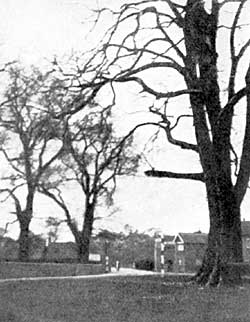
The Village Green with its stately Elm.
Let us turn our attention to the church fabric. On first catching sight of the very matter-of-fact tower we are apt to think "Saxon"—for the weathered columns of double-arched openings of the upper stage suggest mid-wall shafts of this early period. Closer inspection, however, brings disillusionment; but we are rewarded for our inquisitiveness when stepping under the south porch. Here is a doorway of Norman origin, bold, one might almost say brutal, in its simple orders. It is not until we look closer that we discover the vestiges of ornament which the early masons carved into the capitals of the shafts. On the west are traces of whorl, diamond and interlaced work, while opposite there is a suggestion of a double pediment above compartments which may, at one time, have contained some form of figure ornament.
The porch itself claims attention, for built into the fabric are no less than seven incised grave covers, each with its cross of different design—indeed a rich possession. The plate on the east side is, in itself, a very human document, telling a story of benevolence and affection. It reads:
"To the Glory of God and in loving memory of Mary Ann Oldfield this porch was re-erected in the year 1885, by her adopted daughters, E. G. Honey and R. A. Oldfield.
"Her children shall rise up and call her blessed."
Stepping inside we are confronted by the plain cylindrical font, so severe in form that the babes brought to its sacramental bowl seem almost ethereal in contrast. But it is the open timber roof of the nave which gives to the edifice its distinct personality. Simple quatrefoils along the braces serve to keep the eye interested in their curved form.
The plain panelled pulpit bears the name of Thomas Partrik and the date Anno Domine 1604, but whether this records a donor or an incumbent is not certain. Maybe it was some descendant of the "William Patrike, late Fisher, of Fineley" whose will was proved in 1454, when the church was called "St. Oswald," as it is on the notice-board to-day. Within four years of that date, another will, that of George Clay, names the church "St. Trinity," and as Trinity Sunday fixes the date of Finningley Feast, the later will may have given the older dedication. The North Aisle (there is only one) is dedicated to St. Oswald, and probably there was a chapel so dedicated under this roof in the fifteenth century.
Have we here merely a confusion or the echo of those days when Norman conqueror supplanted Saxon holder?
The name of the village itself, quite apart from the Domesday Inquisition, tells of its early origin, when the settlement found its footing upon land which stood like an island midst the lower-lying fens.
How the land to the east has been reclaimed is a story of its own, but the name of Cornelius Vermuyden, the Dutch engineer, will always be closely associated with the schemes which led to the construction of the New Idle, and it was in this connection that he acquired land in Finningley, which in turn he sold to the Dutch statesman, Sir James Cats, in order to help finance his drainage scheme.
These are only two among the long list of men of some celebrity who have, in succession, held Finningley since Swayne answered for the Tax or Geld at Six bovats for his Manor before the Conquest.
The Manor House, rebuilt about 1888, does not come within the scope of the present article, but the name of Frobisher connects it with the stirring times of Elizabeth, and reminds us of the valiant seaman who stands among the great and intrepid navigators of that wonderful age of discoveries.
That in our own time Finningley has numbered heroes among her sons we are reminded by the tablet on the south wall of the church and although the commemoration window beyond the Altar may, by many, be judged something over literal in its rendering, its lesson that sacrifice is but a path trodden through tribulation to higher things meets all those who come within the sacred precincts.
The women of the village are justly proud that those who went forth on their behalf were well remembered by the folk at home, for they were, if not the first, at any rate among the first to maintain a bed for the wounded, providing every comfort and necessity for those whose war-wounds or sickness brought them to the "Finningley bed" in Doncaster Hospital.
Lest it be thought that the church has been the sole centre of religious activity, we are reminded that the Wesleyans of the community raised their own place of worship, which bears date 1838, but one cannot say that the house which their zeal brought into being adds to the beauty of the village.
If you are given to such conceits you will be told that some two-and-a-half miles north-east from the village green, in the direction of Wroot, you may plant your shooting-stick in Nottinghamshire and sit with your left foot in Yorkshire and your right in Lincolnshire— but you must be prepared to get wet.
We must now leave, to travel by way of Bawtry and Ollerton through the glorious colours of the autumn-tinted forest down the Rufford Road, to Nottingham and thence, passing south we turn right before crossing the county borders and run into our most southerly village, Stanford-on-Soar, which will be dealt with in our next issue.
